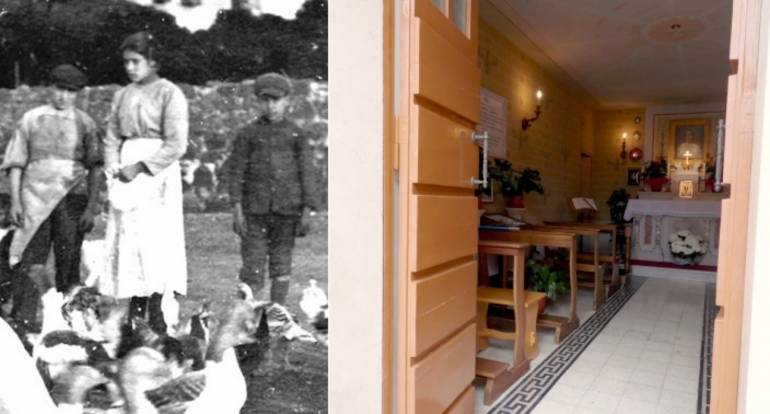'Love your enemies and pray for those who persecute you' (Matthew 5, 38-48)

A. Text:
You have heard that it was said, 'An eye for an eye and a tooth for a tooth.' But I say to you, offer no resistance to one who is evil. When someone strikes you on (your) right cheek, turn the other one to him as well. If anyone wants to go to law with you over your tunic, hand him your cloak as well. Should anyone press you into service for one mile, go with him for two miles. Give to the one who asks of you, and do not turn your back on one who wants to borrow. "You have heard that it was said, 'You shall love your neighbor and hate your enemy.' But I say to you, love your enemies, and pray for those who persecute you, that you may be children of your heavenly Father, for he makes his sun rise on the bad and the good, and causes rain to fall on the just and the unjust. For if you love those who love you, what recompense will you have? Do not the tax collectors do the same? And if you greet your brothers only, what is unusual about that? Do not the pagans do the same? So be perfect, just as your heavenly Father is perfect.
B. Exegesis:
1. This sunny and sizzling Sunday we continue to listen to another portion of Jesus’ Sermon on the Mount: teaching about retaliation and love of enemies. These teachings are very much significant today as we live in a world, full of barbaric and gruesome violence like 9/11 (USA) or 4/21 (Sri Lanka).
2. First, we turn to listen to Jesus’ teaching about retaliation. He teaches in a very methodical way.
First, Jesus presents the thesis – what the Law of Moses has taught: “You have heard that it was said, ‘An eye for an eye and a tooth for a tooth.” Then He makes the anti-thesis – what He teaches of His own divine authority: “But I say to you, offer no resistance to one who is evil.” He does not stop at that point. But He illustrates His statement, the antithesis, with enough practical examples.
For a proper understanding of the Law of Christ, the New Moses, seated in the rabbinic posture of teaching on a mountain, the biblical place of divine revelation; we ought to read through Exodus 21 and Leviticus 24: “Whoever takes the life of any human being shall be put to death … A life for a life! Anyone who inflicts an injury on his neighbor shall receive the same in return. Limb for limb, eye for eye, tooth for tooth!”
These two speak of Lex Talionis, the law of tit for tat. What was the purpose of this Law, though it looks rigorous? It was:
i. to enforce justice
ii. to stamp out violence
iii. to prevent greater penalties than would be just; to moderate vengeance; the punishment should not exceed the injury done.
But Jesus, the One greater than Moses, forbids even this proportionate retaliation and exhorts us, His disciples, to cede our legal rights for retaliation. He seems to say, ‘Do not resist evil with evil.’ He, then, exemplifies His new teaching: “When someone strikes you on (your) right cheek, turn the other one to him as well.”
We must resist evil with what is good, done in full liberty. Hence we may hand over the cloak with tunic; give to the one who asks and lend to the one who borrows. We may also go the extra mile when pressed into service for one mile only (for the Roman garrisons in Israel had the right to acquire goods and services from the native Jews).
3. Now we turn to Jesus to listen to His teaching on love of enemies. Here He exhorts that:
i. we must love not only our neighbor (Leviticus 19,18: ‘neighbor’ = fellow countryman) but our enemy and persecutor also = ‘Do not render evil but love for evil’
ii. we should surpass the usual standards of conduct (i.e., to love those who love and to greet those who greet like tax collectors and pagans do)
iii. we must imitate the example of God the Father who grants the gifts of sun and rain to the good as well as the bad and be perfect like Him.
4. What do these teachings point to? Jesus points to an ideal. The ideal should not be forgotten or lost sight of, even if we fall short of it, or even if we cannot easily attain it.
Is this for individual behaviour only? For us Christians, this is not only for individual behaviour/ spirituality but also for social behaviour/ communitarian spirituality.
5. How did Jesus act according to what He preached? We can collect some data from the New Testament and try to make a synthesis:
i. Jesus did have enemies (Pharisees, Sadducees, etc.) – those who did not agree with Him; those who refused to agree with Him, perhaps to keep their positions.
ii. Jesus did dialogue with them. He accepted invitations to dine with the Pharisees, who disagreed with Him and who questioned Him and His actions at the meal.
iii. It is possible that the meal was an occasion to clarify matters and some enemies were converted to Him – e.g., Matthew, the tax collector; Zacchaeus, the chief tax collector.
iv. It is equally possible that some hardened their hearts against Jesus – e.g. those who refused to agree with Him.
v. Those, who were hardened against Him, put Him to death (i.e. His enemies retaliated Him).
vi. In Luke, He forgave His enemies on the cross – even if He had the possibility to retaliate them: “Father, forgive them, they know not what they do” (23,34).
vii. When Jesus was put to death by His enemies and He did not retaliate at the end, He was merely practising what He preached.
C. Application:

the former hospital where Maria died forgiving her murderer
6. Here is an illustration! Saint Maria Teresa Goretti was born to a poor, illiterate peasant family of Luigi Goretti and Assunta née Carlini in Corinaldo, in the Province of Ancona, then in the Kingdom of Italy, on October 16th, 1890. She, the third of seven children, was an exceptionally beautiful child.
Owing to extreme poverty, the family migrated to a small village in the neighbourhood of Lazio, Nettuno. Maria’s father shared a house with another man, Giovanni Serenelli, who had had two sons. One of them was Alessandro Serenelli.
While her mother and siblings worked in the fields, Maria would cook, sew, watch Teresa, and keep the house clean.
Alessandro, now a young man of twenty, developed a passion for Maria. He made serious sexual advances several times. But the child rebuffed.
On July 5th, 1902, Maria was sitting on the outside steps of her home, sewing one of Alessandro’s shirts and watching Teresa, while Alessandro was threshing beans in the barnyard. Knowing she would be alone, he returned to the house.
He made a passionate assault upon Maria threatening her with death if she refused to gratify his desire. He gave her plenty of time to choose between death and rape. Her answer was, “No, no, no! God does not wish it. If you do that, you will commit a sin, you will go to hell.”
He first choked her, but when she insisted, she would rather die than submit to him, he stabbed her eleven times. She tried to reach the door, but he stopped her by stabbing her three more times before running away. Thus in his frenzy, he had stabbed her no less than fourteen times.
Teresa awoke with the noise and started crying, and when Assunta and Giovanni came to check on her, they found Maria on the floor bleeding and took her to the nearest hospital in Nettuno.
The wounds had penetrated her throat, with lesions of the pericardium, heart, lungs and diaphragm. Surgeons at Orsenigo were surprised that she was still alive. She underwent surgery without anesthesia, but her injuries were beyond the doctors’ help.
Maria wrote the letters of ‘f-o-r-g-i-v-e-n-e-s-s’ with her blood, untainted and crimson. The aroma of forgiveness filled in the hospital chamber, while she was struggling in excruciating pain in the final hours of her life. On the spot, without any delay, the 11-year-old Saint forgave her killer, who had stabbed her 14 times. In the hospital, she murmured, in excruciating pain, these final and forgiving words, “Yes, for the love of Jesus, I forgive him … and I want him to be with me in paradise forever.” How ambitious she was!
She not only forgave him but went on to pray for him. She even desired to have her killer with her in paradise. Is this not something remarkable and enormous for a teenager?
The surgery of the time was not able to save Maria’s life. She received the Last Sacraments, suffered a lot and died. But she had loved the enemy and even prayed for him in total and unequivocal fidelity to the Word of the Lord.
Radio Veritas Asia (RVA), a media platform of the Catholic Church, aims to share Christ. RVA started in 1969 as a continental Catholic radio station to serve Asian countries in their respective local language, thus earning the tag “the Voice of Asian Christianity.” Responding to the emerging context, RVA embraced media platforms to connect with the global Asian audience via its 21 language websites and various social media platforms.














